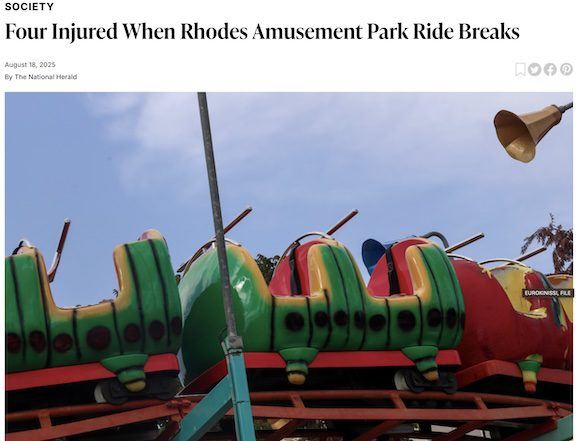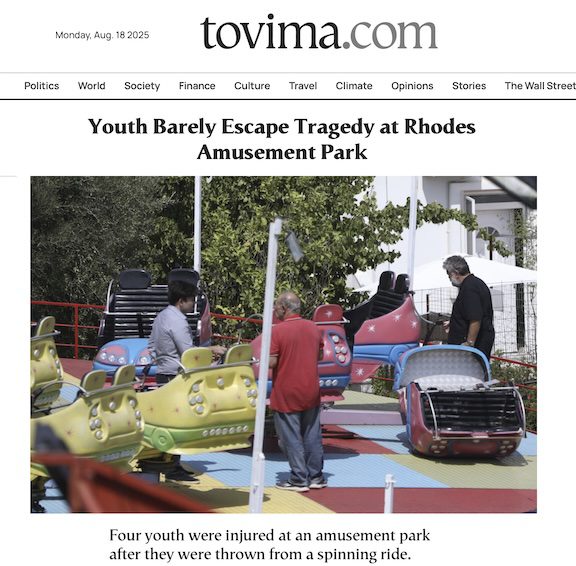Just last week (2025 August 14), there was a scary ride accident involving a derailment of a Wacky Worm kiddy coaster in England. As concerning as the accident was, the BBC News media report and Wales Online reports were very well done. Then this week (2025 August 18) comes a news clip from The National Herald headed “Four injured when Rhodes amusement park ride breaks” with a full-width photo of a Wacky Worm. Two Wacky Worm accidents in one week? Let’s see.
Wales Wacky Worm
Comparing the report to the news report template, BBC News and Wales Online reported:
- Date and time it occurred: Time yes, date not by BBC but yes by Wales Online.
- Specific business or event: The site was named but the owner of the ride was described as a “third party company” and not specifically named. Readers might be keen to know.
- Location city, state, and country: named the park and county, and enough context to decipher the country. The name Wales Online is a convenient clue.
- Name of the specific ride involved: not only was the ride correctly named, but a correct photo was included. (The accident ride has not changed the manufacturer’s name of the ride, which is helpful in this regard.)
- Differentiate a ride accident from ride stoppage: correct.
- Nature of the event. Correctly describes event as derailment. Eyewitness uses the term “derailed”. Photo of the accident ride shows a ride vehicle not in contact with the rails.
- Stage of the ride cycle when event occurred: while this is not explicitly stated, from context, the derailment could only occur during the ride cycle. Wales Online explicitly stated that the derailed vehicle was at the back of the train. BBC photos show the train going downhill with the rear vehicle off the rails, but someone unfamiliar with the ride may not know if this is the front or the back.
- Casualties: described 13 children and one adult with minor injuries, seven sent to hospital. BBC is unclear if these are among the 13 but Wales Online makes this clear. Mentions a child losing teeth on impact with positioning bar (clearly a rider) and another child with a bump on his head who can be identified from context as a bystander in a baby stroller struck by a railing. It is not clear if he was counted among the 13 injured or seven sent to hospital.
Kudos to BBC News and Wales Online and to the park’s public statement for the information. This deserves a 90% score from this blog! Unanswered questions are the specific date, and specific third party owner. There were also questions about the “metal railing” that fell onto the pram (baby carriage or stroller) of a bystander. The Wacky Worm railing is attached to the track support structure. It is unclear if the derailment damaged the railing or a railing failure caused the derailment. Among the injured, it is not clear which injured were passengers on the ride and which were spectators or bystanders.
Rhodes Ride Report
The news article lands on the following:

- Date and time. No.
- Specific business or event: No. But it does name a different park previously closed as a result of a different case.
- Location city, state, and country: Greece, mentions Rhodes, and cites another news site identifying the Kremasti area.
- Name of the specific ride involved: literally the only description is “the ride they were on”. It does continue to say “sending them spinning off onto the ground on the island of Rhodes.” (This would be remarkable if they were not already on the island of Rhodes.) The key art at the head of the article is unmistakeably a Wacky Worm.
- Differentiate a ride accident from ride stoppage: correct.
- Nature of the event. “the ride they were on broke, sending them spinning off onto the ground”.
- Stage of the ride cycle when event occurred: not specifically stated, but the description suggests the ride was in motion, in order that the injured could be sent spinning off, as described.
- Casualties: Four people aged 18 – 20.
Thirty percent of the report (one and a half of its five sentences) was focused on past injuries and regulatory oversights. The description of “spinning off” is inconsistent with the energy on the rider’s body in a Wacky Worm. It is also improbable that four people aged 18 – 20 would be riding a Wacky Worm without small children, except as a stunt.
These inconsistencies led to additional media searching, finding a fuller report which includes a YouTube link that appears to show the ejection. The ride involved was a Tagada!!
This blog will stay out of it, and defer to Wikipedia as describing “Tagada rides are often associated with injuries“. The Tagada is a turntable on a slope. Riders are seated around the perimeter, facing the centre. There are no restraints of any kind. Individual riders are free to stand up while the ride is in motion. In addition to rapid rotation around a tilted (not vertical) axis, the turntable is pumped up and down by structures below. This creates an unpredictable ride action for the rider, although it is often operated manually to accentuate the disorientation and produce pratfalls of more daring riders. Due to the unmitigated hazards, Tagada rides are not permitted in many jurisdictions. (A kiddie ride with seat belts that resembles the appearance of a Tagada is permissible.) Not only are rider ejections common due to the high centrifugal forces, but once a rider has been ejected, the Tagada is not usually surrounded by surfaces that can absorb the energy, so the injuries can be severe or fatal. That risk profile is for an intact Tagada. In this case, there appears to have been a structural failure of the device.
While the news report describes “seating collapsed” and “the seats and the protective railing tore off”, the images do not show clearly what has detached because they are videos and motion blur makes it difficult to see. The video of the ride in motion shows many riders semi-standing in front of the bench seats, supporting themselves with their arms against the railing / backrest. Attempting to stand is hazardous but typical Tagada rider behaviour. At the moment of ejection, a segment of the seating backrest has failed, and the riders leaning on that segment are ejected. The coverage in ekathimerini.com reported that the operator held the required certifications and permits to operate. Kudos to ekathimerini.com for capturing the event clearly and providing clear visuals. The original media report with the Wacky Worm key art is a fail.
A third media report was also located. This described the date and time, the specific event (but not the owner/operator, just the ages of the owner and operator), the location, the specific ride (using the English translation of the Greek name “the plate”). It was not as clear about the nature of the event, described as “the ride broke, throwing them off the ride and onto the ground”. The stage of operation and number of casualties was reported, and links to an Instagram clip showing the riders’ impact with a surrounding fence.
The third report might have earned kudos also, had it not used misleading key art. The photograph used to head this report is from a 2024 fatality where a seat detached from its post on a completely different type of ride. Reference to relevant history is valid context, as described in the news report guideline, but urges that reporters avoid implying common causation for dissimilar unrelated past events and should make the transition from current event to past event(s) clear to the reader. Using a photo of the past event as key art for the current event steps far over this line.

